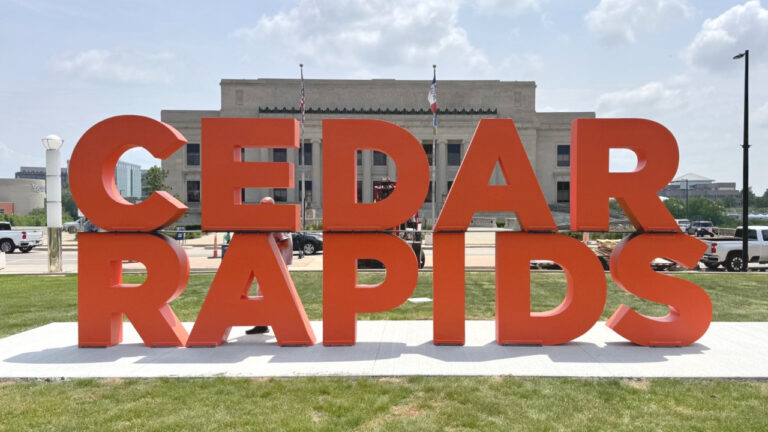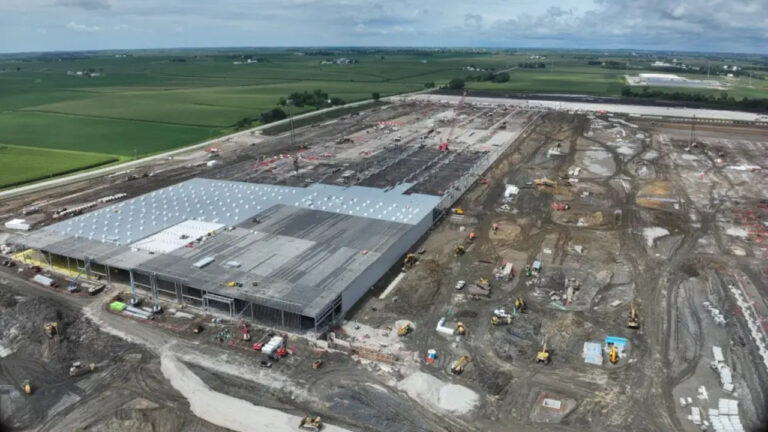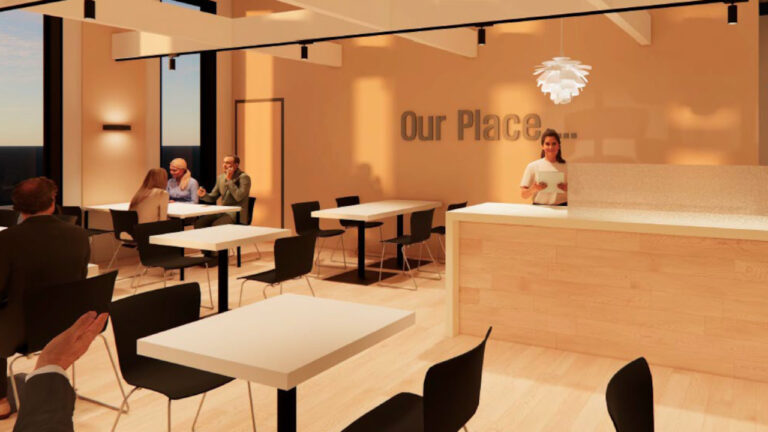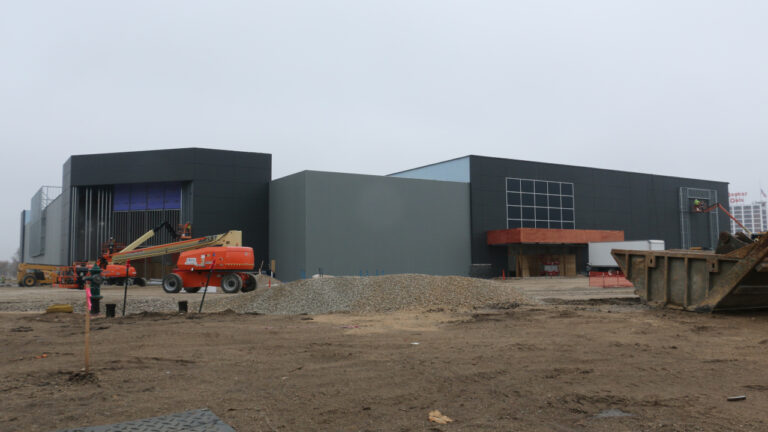The Iowa Board of Regents on Aug. 2 approved schematics for the new 45,000-square-foot University of Iowa Museum of Art, to be built on a parking lot between the Main Library and Recreation Center. RENDERING BNIM ARCHITECTS
By Emery Styron
[email protected].
In the past three years, more “fans” – 1.5 million, in fact – flocked to see a single painting owned by the University of Iowa than crowded into Kinnick Stadium to watch Hawkeye football. That’s a statistic interim UI Museum of Art (UIMA) Director Jim Leach enjoys tossing out to showcase the arts’ economic punch.
That impact will only grow when Jackson Pollock’s “Mural” and the rest of UI’s 15,500-item, $500 million art collection return from flood hiatus to their new campus home. Mr. Leach predicts UI’s $50 million, 45,000-square-foot art museum will quickly become a regional “cultural tourism destination” when it opens in 2020.
“Mural,” which has been exhibited at museums across the nation and globe the past nine years, “is a stupendous cultural attraction, but so is the museum’s entire 20th century modernism collection,” notes Mr. Leach, who represented Eastern Iowa for 30 years in Congress and served a term as chair of the National Endowment for the Arts. The museum will attract visitors, who will shop, dine out and stay overnight, as well as academic conferences, generating spin-off meals, receptions and other activities on and off campus, he said.

UIMA’s holdings feature prominent artists from Braque and Picasso to Beckmann, Miro, Chagall and Wood. In addition, there are Asian and American prints, ceramics “of terrific interest to discrete constituencies from near and far” and an “exceptional collection” of African pieces, many of them originally acquired by the Stanley family of Muscatine, Mr. Leach said.
The museum, designed by Des Moines-based BNIM Architects, will join other stunning new structures creating a buzz in architectural circles, including the new Hancher Auditorium, Voxman Music Building and Visual Arts Building – also designed by BNIM (see sidebar).
The new UIMA will be the fourth arts building to rise since floods ravaged the campus in 2008, forcing the closure of 20 structures, affecting 2.5 million square feet of building space and racking up $743 million in damage and recovery costs.
The Federal Emergency Management Agency (FEMA) provided $270 million of the $420 million needed for the new Hancher and Visual Arts Building on the Arts Campus, and Voxman downtown, but funds for the new UIMA must all come from private sources.
More than 2,000 businesses and individuals donated to build the existing museum at 150 N. Riverside Drive, which can no longer house the collection for insurance reasons. Now known as the Old Museum of Art, it was completed in 1969 after Owen and Leone Elliott of Cedar Rapids offered the university their extensive European art collection, contingent on its matching of funds raised for the building.
The new museum will exhibit works only on the second floor and higher, starting at four feet above the 500-year flood level. It will be smaller than the Old Museum of Art, but has been designed with exceptional efficiency and room for expansion, said Elizabeth Wallace, UIMA’s manager of communications, marketing and membership.
Mr. Leach is especially excited about the new museum’s “cross-river location” between the university main library and recreation center, each of which attract at least 1.5 million visitors a year. The idea of giving non-arts majors easier access to “inspiring examples of creativity” appeals to Mr. Leach, and he says students and scholars will better understand “the social context for art making” by rubbing shoulders with a wider cross-section of humanity in the gateway location.
The Iowa Board of Regents’ Aug. 2 approval of building schematics cleared the way to begin fund-raising. Ms. Wallace is undaunted by the challenge.
“There is a lot of enthusiasm, energy and hope surrounding this project,” she said. “We are lucky to have a community that deeply values and supports the arts.”
A ‘big moment’
After the flood, UIMA was able to store and display a big part of its collection, including the Pollock, at Davenport’s Figge Museum. The rest resides at various spots on campus, including Iowa Memorial Union’s Black Box Theatre. UIMA has also become much more of a virtual institution, with many of its works and their histories viewable online.
Steve McGuire, interim director of the School of Art & Art History, says replacing the museum and reassembling the collection “will mean that the arts campus is complete. That sounds fairly straightforward, but it will be a very big moment in the history of the university. It means our curriculum is enhanced.”
Art history professor Joni Kinsey agreed, saying “The museum isn’t just an ornament. It’s an active component for education, with internships, part-time jobs and research projects … a laboratory no less than a science lab.”
She sends her students, who often go on to be art curators, to the museum to analyze paintings and develop in-depth projects like actual or “on-paper” exhibits.
In the meantime, “Mural”, donated to UI by New York City collector Peggy Guggenheim in the early 1950s, serves as “an exceptional and important ambassador for the university and the state,” Ms. Wallace said.
The painting’s early post-flood travels included stops in Davenport, Des Moines and Sioux City. Research scientists at the Getty Conservation Institute and conservators at the J. Paul Getty Museum in Los Angeles finished a two-year technical study and conservation treatment that removed darkened shellac, revealing the painting’s original vibrant colors. “Mural” then spent two years abroad before returning to the U.S. this spring.
It is on display at the Nelson-Atkins Museum of Art in Kansas City through the end of this month, and will then go to the National Gallery of Art in Washington, D.C., until next October.








